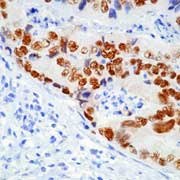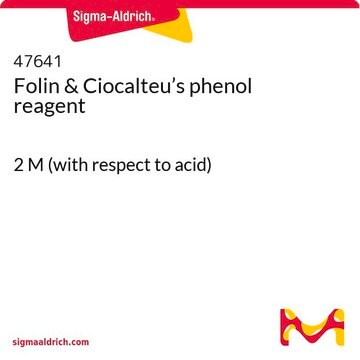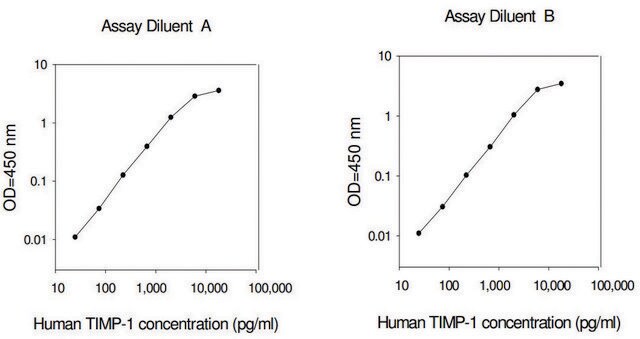推荐产品
生物源
mouse
品質等級
抗體表格
purified antibody
抗體產品種類
primary antibodies
無性繁殖
DO-7, monoclonal
形狀
liquid
不包含
preservative
物種活性
bovine, monkey, human
製造商/商標名
Calbiochem®
儲存條件
OK to freeze
avoid repeated freeze/thaw cycles
同型
IgG2b
運輸包裝
wet ice
儲存溫度
−20°C
目標翻譯後修改
unmodified
基因資訊
human ... TP53(7157)
一般說明
Purified mouse monoclonal antibody generated by immunizing BALB/c mice with the specified immunogen. Recognizes the ~53 kDa wild-type and mutant forms of p53.
Recognizes the ~53 kDa wild-type p53 and mutant p53 protein in SKBR-3 and MDA-231 cells and in colon carcinoma tissue.
This Anti-p53 (Ab-12) (Pantropic) Mouse mAb (DO-7) is validated for use in Frozen Sections, Immunoblotting, IF, IP, Paraffin Sections for the detection of p53 (Ab-12) (Pantropic).
免疫原
Epitope: within amino acids 37-45 of p53
recombinant, human p53 expressed in E. coli
應用


Frozen Sections (1-2 g/ml)
Immunoblotting (1-2 g/ml)
Immunofluorescence (0.5 g/ml)
Immunoprecipitation (2 g/mg lysate)
Paraffin Sections (1-2 g/ml)
包裝
Please refer to vial label for lot-specific concentration.
警告
Toxicity: Standard Handling (A)
分析報告
Positive Control
SKBR-3 or MDA-231 cells or colon carcinoma tissue
SKBR-3 or MDA-231 cells or colon carcinoma tissue
其他說明
Exhibits nuclear staining in tumor cells. Antibody should be titrated for optimal results in individual systems.
Greenblatt, M.S., et al. 1994. Cancer Res.54, 4855.
Lane, D.P. 1992. Nature358, 15.
Lane, D.P. 1992. Nature358, 15.
法律資訊
CALBIOCHEM is a registered trademark of Merck KGaA, Darmstadt, Germany
未找到合适的产品?
试试我们的产品选型工具.
儲存類別代碼
11 - Combustible Solids
水污染物質分類(WGK)
WGK 1
閃點(°F)
Not applicable
閃點(°C)
Not applicable
Jinichi Mori et al.
Cancer science, 107(3), 298-306 (2016-01-13)
In response to various cellular stresses, p53 is activated and inhibits malignant transformation through the transcriptional regulation of its target genes. However, the full picture of the p53 downstream pathway still remains to be elucidated. Here we identified cystatin C
Jinichi Mori et al.
Neoplasia (New York, N.Y.), 19(3), 185-195 (2017-02-06)
p53 activation by cellular stresses induces the transcription of hundreds of its target genes. To elucidate the entire picture of its downstream pathway, we screened a cDNA microarray dataset of adriamycin-treated HCT116 p53-/- or p53+/+ cells and identified EPSIN 3
Tomoyuki Koguchi et al.
International journal of oncology, 48(6), 2415-2424 (2016-04-02)
In response to various cellular stresses, p53 exerts its tumor suppressive effects such as apoptosis, cell cycle arrest, and senescence through the induction of its target genes. Recently, p53 was shown to control cellular homeostasis by regulating energy metabolism, glycolysis
Takafumi Miyamoto et al.
Science advances, 3(5), e1603204-e1603204 (2017-06-01)
The transcription factor p53 is at the core of a built-in tumor suppression system that responds to varying degrees of stress input and is deregulated in most human cancers. Befitting its role in maintaining cellular fitness and fidelity, p53 regulates
Franz Meitinger et al.
The Journal of cell biology, 214(2), 155-166 (2016-07-20)
In normal human cells, centrosome loss induced by centrinone-a specific centrosome duplication inhibitor-leads to irreversible, p53-dependent G1 arrest by an unknown mechanism. A genome-wide CRISPR/Cas9 screen for centrinone resistance identified genes encoding the p53-binding protein 53BP1, the deubiquitinase USP28, and
我们的科学家团队拥有各种研究领域经验,包括生命科学、材料科学、化学合成、色谱、分析及许多其他领域.
联系技术服务部门






